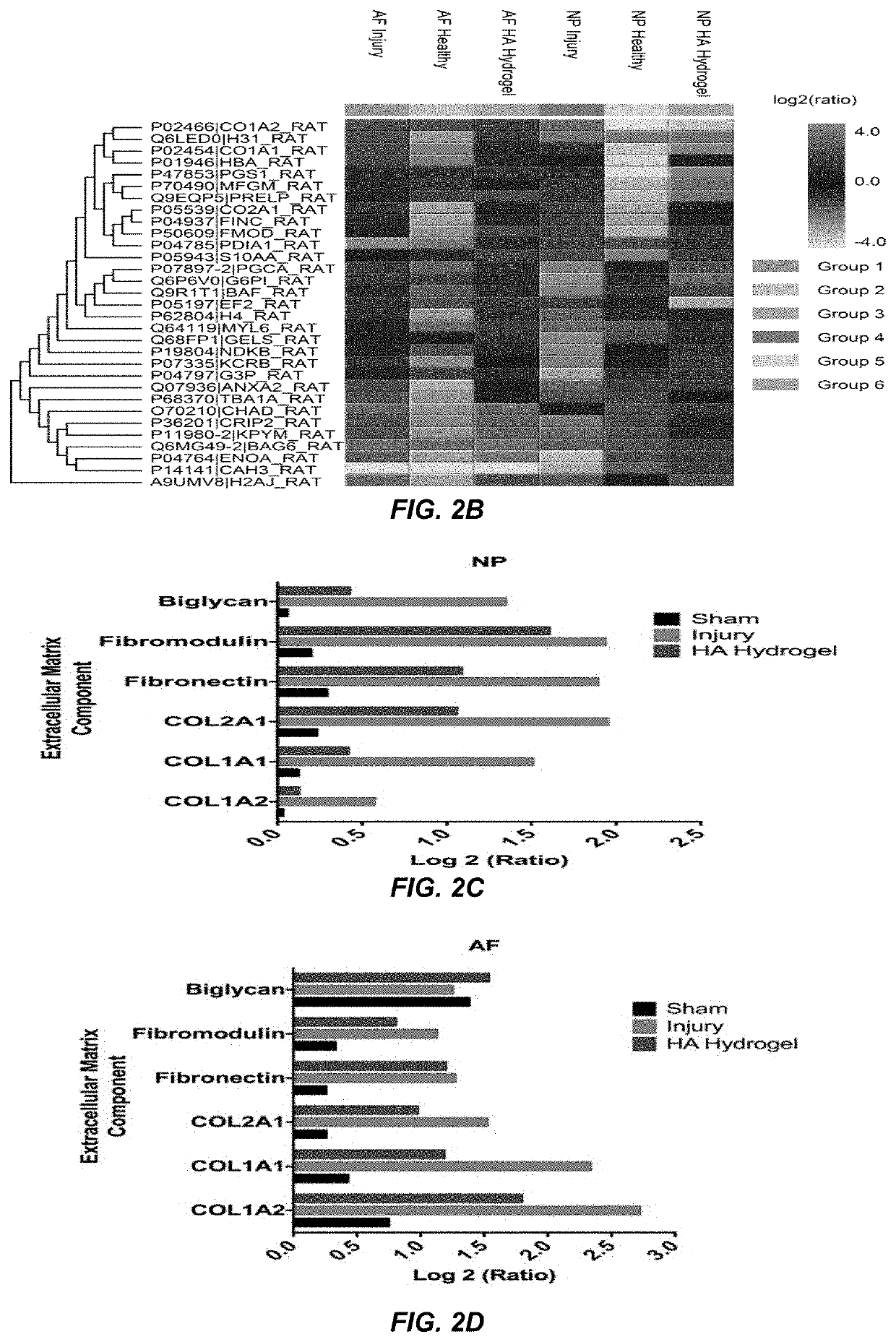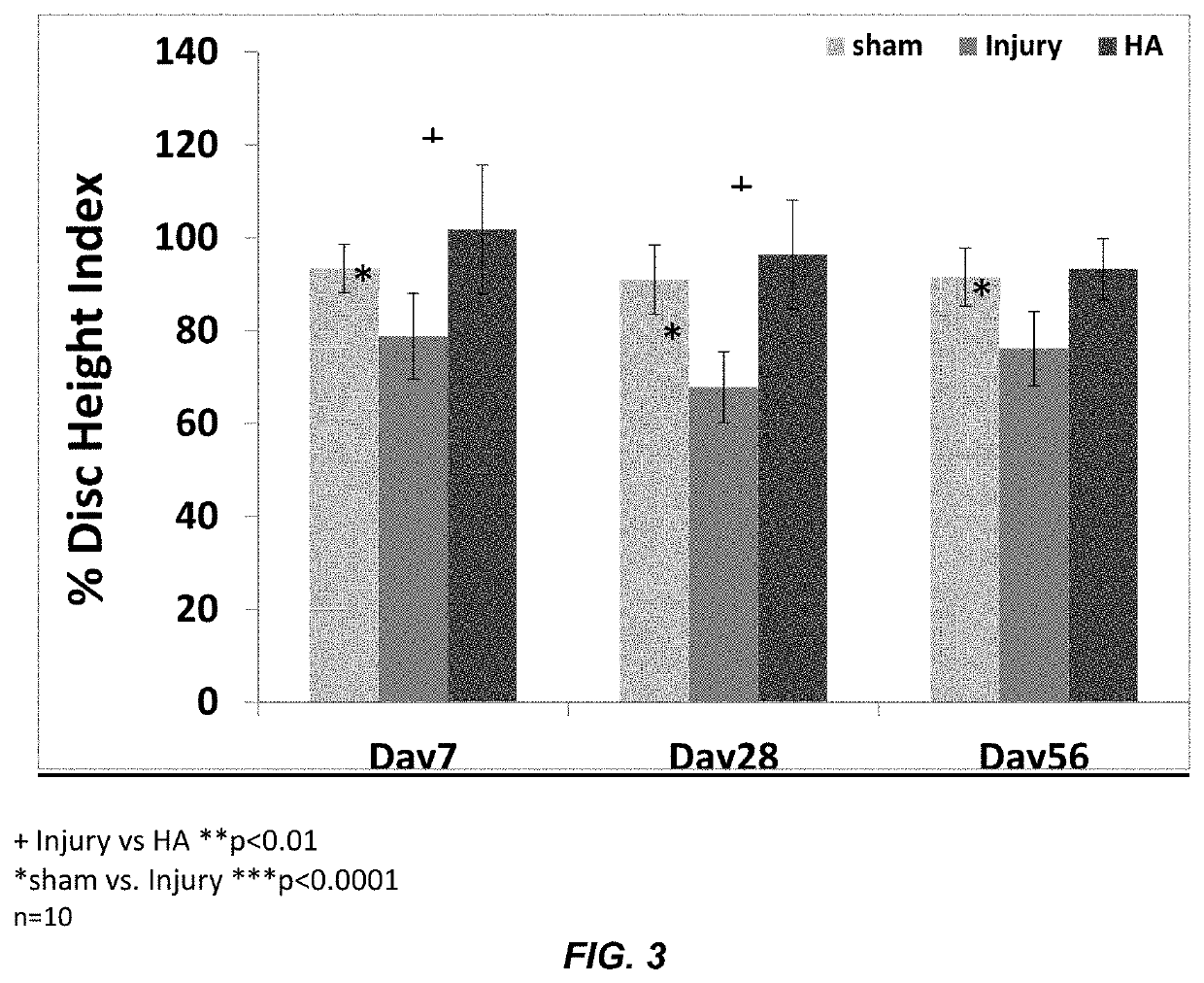Regeneration of diseases intervertebral discs
a technology of intervertebral discs and disease, which is applied in the field of regenerative of diseased intervertebral discs, can solve the problems of increased back pain, severe socio-economic impact, and extensive bone work, and achieve the effects of reducing discogenic pain, reducing discogenic pain, and increasing the height of the treated dis
- Summary
- Abstract
- Description
- Claims
- Application Information
AI Technical Summary
Benefits of technology
Problems solved by technology
Method used
Image
Examples
example 1
Protocol for Non-Cross Linked, Cross-Linked HA Hydrogels
[0085]Material Specifications:
[0086]Hyaluronic acid: High molecular weight (HM Wt.) sodium hyaluronate 1 M. Da (Lifecore Biomedical, USA). CAS No.: 9067-32-7.
[0087]PEG-amine: Mw 2000 Da purchased from JenKem Technology USA (Allen, Tex.). CAS No.: 25322-68-3, purity>95%.
[0088]N-(3-Dimethylaminopropyl)-N′-ethylcarbodiimide hydrochloride (EDC) (Sigma-Aldrich, USA) CAS Number 25952-53-8, purity˜100%.
[0089]N-hydroxysuccinimide (NHS): (Sigma-Aldrich USA). CAS Number 6066-82-6, purity 98%.
[0090]Phosphate buffered saline (Sigma-Aldrich, USA) CAS Number P4417-50TAB (pH adjusted to 6.5)
[0091]Formulation or Compounding Procedure for Non-Cross Linked Gels:
[0092]1. Prepare Phosphate buffered saline by dissolving 1 tablet in 200 ml distilled water, and adjust the pH to 6.5 (store aside).
[0093]2. Slowly add required quantities of Hyaluronic acid sodium salt (3 mg / ml, 9 mg / ml, 15 mg / ml) in Phosphate buffered saline at ≤25° C.
[0094]3. Stir the ...
example 2
Protocol for Crosslinking of HA
[0101]Material Specifications
[0102]Hyaluronic acid: High molecular weight (HMwt) sodium hyaluronate 1.2×106 Da (Lifecore Biomedical, USA). CAS No.: 9067-32-7.
[0103]PEG-amine: Mw 2000 Da purchased from JenKem Technology USA (Allen, Tex.). CAS No.: 25322-68-3, purity>95%
[0104]N-(3-Dimethylaminopropyl)-N′-ethylcarbodiimide hydrochloride (EDC) (Sigma-Aldrich USA) CAS Number 25952-53-8, purity˜100%
[0105]N-hydroxysuccinimide (NHS): (Sigma-Aldrich USA). CAS Number 6066-82-6, purity 98%
[0106]Solvents: 20 wt % sodium sulphate solution in distilled water and 0.1 M MES (2-(N-morpholino)ethanesulfonic acid) buffer
[0107]Evaluation of Synthetic Protocol for Cross-Linking of HA (EDC / NHS)
[0108]1. 10 mg / mL conc. HA was dissolved in 0.1 M MES buffer for 2 h at room temperature
[0109]a. MES buffer facilitates rapid dissolution of HA to obtain a homogeneous solution
[0110]b. MES buffer (pH˜6) also facilitates ionization of the carboxylic groups of HA (pKa˜3-4)
[0111]2. A sol...
example 3
Disc Height Data (FIGS. 1 and 3)
[0135]An in vivo study was conducted in rat-tail model to check the anti-inflammatory effect of hyaluronic acid (HA) microgel. Animals used in this study were 250-350 g of 12 weeks old female rat Sprague Dawley. The experimental design consisted of sham, injury and injury+implantable HA hydrogel groups that have been done on each rat at disc level C4-C5, C5-C6, and Disc C6-C7. The injury was performed by excising out 1×1×1 mm (width, height and depth) of tissue using blade. Then, after inducing the injury, the discs were left as it is or implanted with HA hydrogel depending on the experimental group. The wound was closed in layers using non-absorbable suture, first by suturing the connective tissue layers and then the skin, thereby covering the disc. Analgesics post-surgically and for the next few days (usually for 72 hours) with buprenorphine hydrochloride 0.025 mg / kg every 12 hours, if needed more frequent. After 28 days post-operative, the rats wer...
PUM
| Property | Measurement | Unit |
|---|---|---|
| weight % | aaaaa | aaaaa |
| weight % | aaaaa | aaaaa |
| weight % | aaaaa | aaaaa |
Abstract
Description
Claims
Application Information
 Login to View More
Login to View More - R&D
- Intellectual Property
- Life Sciences
- Materials
- Tech Scout
- Unparalleled Data Quality
- Higher Quality Content
- 60% Fewer Hallucinations
Browse by: Latest US Patents, China's latest patents, Technical Efficacy Thesaurus, Application Domain, Technology Topic, Popular Technical Reports.
© 2025 PatSnap. All rights reserved.Legal|Privacy policy|Modern Slavery Act Transparency Statement|Sitemap|About US| Contact US: help@patsnap.com



